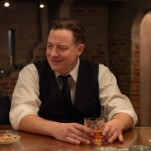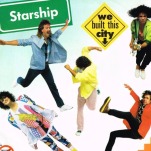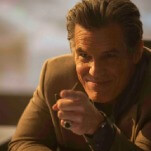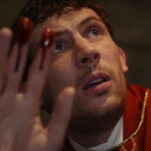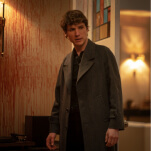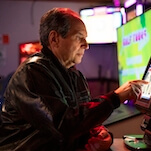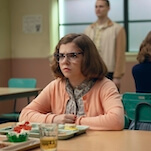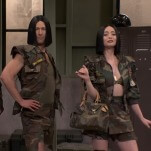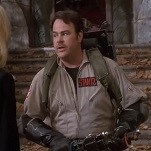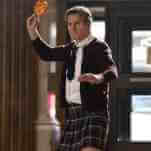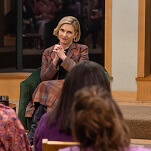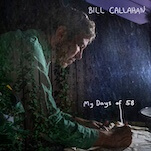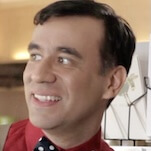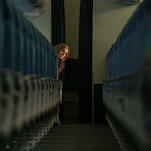Scientists aren’t traditional TV heroes. You only find them on spaceships of the future, where their jobs consist of cyber-stating tachyon technobabble, or in labs on crime procedurals, where their jobs consist of posing for montages. To paraphrase science-fiction author Arthur C. Clarke, TV science is indistinguishable from magic. Hence Walter Bishop from Fringe, Rick from Rick And Morty, and Princess Bubblegum and Simon Petrikov from Adventure Time.
Cops, lawyers, politicians, businesspeople, small-town innkeepers, stalkers—the closest TV tends to come to science is in medical procedurals. It’s just trial and error until the hour’s up, modeled on dramatic formulas rather than chemical ones. But Dr. House and his team are ostensibly engaged in the process of science. They have a problem (a patient has symptoms), they come up with a hypothesis that explains the problem (lupus), and they test it (steroids). When they get a new variable, the negative reaction to the initial treatment in Act 3, they take that into consideration and come up with a new hypothesis. True to its Sherlock Holmes roots, House is more about logic than medical experimentation, but logic is the language of science. Every week House tries to come up with a model to explain the world, and he tests it until he’s right. In that light House is a sturdy stepping stone from Star Trek to Breaking Bad.
True to Arthur C. Clarke, science on Breaking Bad starts out as magic. Walter White is a superhero/supervillain whose powers are that he knows a thing or two about chemistry. He uses that expertise to suddenly incapacitate some gangsters in the pilot. A few episodes later, when the local drug lord named Tuco starts leaning on his operation, White saunters into the guy’s apartment with a bag of what looks like product but is in fact fulminated mercury, an explosive. Tuco thinks Walt’s an idiot for bringing him more meth, but Walt corrects him. “You got one part of that wrong. This,” he says, holding up a crystal, “is not meth.” He throws it at the ground and it blows out Tuco’s windows. That season is like the first day of chemistry class when the teacher shows the students all the cool things chemistry can do. Once we’re hooked, it’s all calculated lab work and exacting precision and accounting for human error.
Indeed, much of the rest of the show is concerned with the work of science, testing a hypothesis, collecting empirical data, and replicating results. Over the course of the series, Heisenberg comes up with multiple formulas for methamphetamine. When a bad batch comes out, he works out exactly where the error seeped into the process. The classic episode “Fly” is named after the one little unaccounted-for variable buzzing around the hermetic crank kitchen. Even when plots aren’t about chemistry, Walt applies the scientific method. When an incriminating laptop winds up in an evidence locker at the police station, he experiments with an electromagnet powerful enough to wipe it. He manufactures ricin, a practically untraceable poison, as well as a bomb and a remote-controlled machine gun. The excitement comes from how he weaponizes science, but Vince Gilligan and company never skimp on the problem-solving itself. That’s how they produced a show about a scientist that doesn’t make science look like magic. It’s the same formula for making an airtight thriller: Show as much of the process, from problem to solution, as possible.
Of the three scientist dramas that followed, Masters Of Sex is the softest, as it were. Michael Sheen and Lizzy Caplan play real-life sex researchers Dr. William Masters and Virginia Johnson. They work at a university (and a brothel, and various bedrooms) in St. Louis, collecting data on sex. As a ’50s domestic drama, Masters thrives on the tension between stifling public attitudes and liberating private lives. It’s a show where Bill Masters can be a model of repression at home and argue passionately for the value of sex research at work. Knowledge is next to freedom. The enemy is the irrational, as in social concern trolling and entrenched patriarchal gender politics. Naturally, those obstacles generate stories about the practicalities of science. As university researchers, Masters and Johnson have to worry about funding and equipment and how to publish their findings. The kind of stuff an older show might skip over is mined for drama as well as pay-cable titillation.
As on many dramas, including Manhattan and to a lesser extent The Knick, the work becomes so consuming that the home life suffers. Which means showrunner Michelle Ashford gives ample spotlight to the actual scientific research of Masters and Johnson. Advancing human knowledge starts with simply understanding how sex works among assorted locals. In the beginning Masters is hiding in a prostitute’s closet timing her dalliances with a stopwatch. Soon he graduates to more precise instruments, charting the body’s physiological response to masturbation and vaginal and anal intercourse with electrodes. Masters even invents a magnificent magnifying dildo so a researcher can better see what’s going on inside a vagina during sex. There couldn’t be a better symbol for the show.
True to the anachronistic Cliff Martinez score and the cool Steven Soderbergh visuals, The Knick’s titular turn-of-the-century New York City hospital is the seat of a cultural and scientific revolution. Every week there’s a new invention. The hospital goes electric in the first episode. Thomas Edison stops by to show off his wax recordings. A salesman hawks new X-ray machines. Clive Owen’s Dr. John Thackery pioneers the use of cocaine as a sedative, but for much of the season he’s stymied by the placenta previa procedure. The surgeries are choreographed like action scenes, battles against the limits of the human body and the limits of available technology. When a perfect operation fails, Dr. Thackery has to come up with a new procedure. He tests on pigs, cadavers, and sometimes, live prostitutes. Brainstorming with an associate, he realizes he can’t perform the surgery any faster, so he has to get the patient to die slower. That’s when they hit on the idea to insert a bladder in the uterus to suppress bleeding. They had to look at their problem from another angle and expand their minds to hit on a possible solution. Thackery is a good mad scientist. In one failed surgery, he tries to buy time by reaching up a patient’s chest cavity and pumping the patient’s heart with his hand. Another doctor picks up a pulse, but it’s artificial. They lost the patient, but Thackery takes a kind of wild solace in that discovery. “We’ll find a use for it,” he says.
Andre Holland’s Dr. Algernon Edwards is in fierce competition with him. Thackery’s always inventing new medical instruments, but Edwards might have the claim to the biggest when he repurposes an electric vacuum for surgical use. The first placenta previa operation of the series is scored by the creaky hand crank filling up jars of blood, emphasizing not only the loss of life but the antiquity of the procedure. This electric suction is a landmark. Edwards also comes up with a new hernia repair, carried out by another doctor reading Edwards’ notes as he goes. The Knick has all the stuff of your average hospital drama—relationships and social issues and finance troubles—but what sets it apart is Soderbergh’s procedural focus on the science.
Set in New Mexico and regularly referring to someone called Heisenberg, Manhattan is a chip off the old block. It’s the story of the nuclear physicists who invented the atomic bomb in the Manhattan project, cast as a paranoid small-town ensemble drama complete with a glassy, tense Jónsi & Alex score. The Heisenberg is Werner, the German nuclear physicist; Robert Oppenheimer and Niels Bohr also come and go as they please. Dramatically they’re treated like royalty, because science builds on itself. Our heroes, led by John Benjamin Hickey’s Dr. Frank Winter, would be much further behind without them. Winter’s men are the grunts, forever writing out equations on chalkboards, making calculations, and brainstorming theory. There’s a radiation mystery, accidental plagiarism, high jinks involving swallowed plutonium—all manner of science-related plots from the making of a reputation to the practice itself.
The Knick is as hands-on as it’s possible to be, and Masters Of Sex is mostly observation. But the science on Manhattan is almost all abstract, give or take a test explosion in the desert. Like Breaking Bad, the science is a bit technical for a lay audience. From a dramatic standpoint, we don’t really need to know what Frank Winter’s “implosion model” is. All that matters is it’s different from his better funded rival Dr. Akley’s (David Harbour) Thin Man design. But creator Sam Shaw, who worked on Masters Of Sex, both trusts the audience not to tune out and tries to simplify by breaking these concepts down to a single stumbling block per episode. When Winter is trying to figure out how to get a bomb to implode and Dr. Charlie Isaacs suggests a variable burn rate, complete with hand gestures, viewers get the gist even though it’s likely that, pausing to think about it, they really don’t know what he means at all. That’s true of The Knick, too, but Soderbergh’s such a process geek that it feels like viewers understand exactly how these operations work just from watching him connect the dots.
One byproduct of the proliferation of TV drama is the diversity of subjects. Now we have shows about athletes, plastic surgeons, and trans women. We also have the engineers of Halt And Catch Fire, the epidemiologists of The Strain, the mad doctors of Penny Dreadful, all often engaged in scientific pursuits. Scientists are a refreshing change of pace from cops and crooks. While there are sometimes life or death stakes on science dramas—or indeed the apocalyptic death tolls on Manhattan—the stories are about how to overcome obstacles without the easy drama of a gun. To show the work of science is to show the process behind the magic, and to demonstrate how to take the unknown and explain it. Science is problem-solving. That’s the very stuff of drama.

